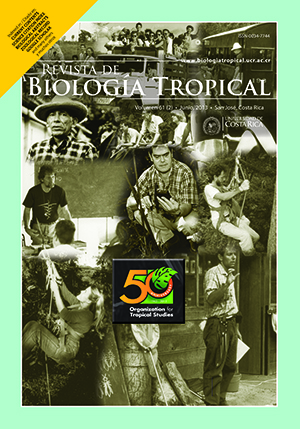Abstract
Insects have been recognized to be important indicators of the quality elements of ecosystems, among others, because of their rapid response to environmental variability and ease cost-effective capture. In this work we evaluated whether beetles of the Scarabaeoidea superfamily may be used as bioindicators of anthropogenic disturbance of Amazonian terra firme rain forests, in order to provide guidelines for monitoring strategies of the Amacayacu National Park. We considered three different levels of anthropogenic disturbance (i.e. low, medium, high) in 12 transects (four in each intervention level), and caught all beetle species of this superfamily. Three interception traps, two light traps, three pitfalls and four bottle fruit traps were used per transect, as well as manual catch. In total, 593 individuals belonging to 92 species, 44 genera and seven families were collected. Scarabaeidae (n=232, 27 spp.) and Dynastidae (n=161, 26 spp.) were the families with the highest number of individuals and species, while Aphodiidae, Cetoniidae and Geotrupidae exhibited the lowest. The most abundant species per family were Ateuchus sp. (33.2%) from Scarabaeidae, Cyclocephala verticalis (55.9%) from Dynastidae, Astaena sp. (75.8%) from Melolonthidae, Ceratocanthus amazonicus (66.7%) from Ceratocanthidae y Chaetodus asuai (96.8%) from Hybosoridae. Results showed that the number of species and individuals increased with the anthropogenic disturbance. The Margalef and Shannon indexes also revealed that the highest richness and equity occurred in the high-disturbed site, respectively. Dynastidae exhibited the highest number of exclusive species per gradient, while Scarabaeidae shared most of its species. Ten species were recorded in the three disturbance levels, 26 species in two and 56 species were exclusive to one level. The most abundant species Chaetodus asuai (Hybosoridae) presented a significant decrease in the number of individuals as disturbance increased, while an inverse relationship occurred for C. verticalis (Dynastidae). For Astaena sp. (Melolonthidae) and Ligyrus gyas (Dynastidae) a high number of individuals was recorded and were exclusive for one forest site (low and high disturbed forest, respectively). The complete superfamily cannot be used like a single bioindicator element because it displays, in a specific level, very different behaviors in each disturbance condition. We discuss the use of richness and diversity as indicators of disturbance, while we highlight abundance of particular taxa as a better metric for disturbance.##plugins.facebook.comentarios##
Downloads
Download data is not yet available.






